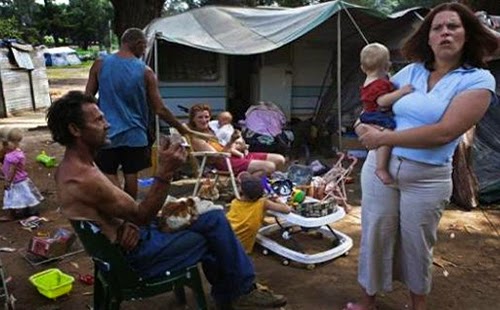Four in 10 American children live in low-income families, new report shows
Four out of every ten American children live in low-income families, according to new research from the National Center for Children in Poverty (NCCP) at Columbia University’s Mailman School of Public Health. This finding from the 2015 edition of the center’s Basic Facts about Low-Income Children fact sheet series underscores the magnitude of the problem of family economic insecurity and child poverty in the United States. Analyzing the latest available U.S. Census data, NCCP researchers find that 44 percent of children under age 18 lived in low-income families in 2013, and 22 percent lived in poor families. Low-income families are defined as those with incomes less than two times the Federal Poverty Threshold (about $47,000 for a family of four with two children) and poor families are defined as those with incomes below the threshold (about $24,000 for a family of four with two children).
“Far too many American children live in economically insecure families, and this serious threat to our nation’s future does not get the attention it deserves,” said NCCP Director Renée Wilson-Simmons. “NCCP’s Basic Facts about Low-Income Children provides essential data to raise awareness about our most vulnerable children.”
Published annually since 2009, Basic Facts about Low-Income Children offers demographic and socioeconomic profiles of poor and low-income children in different age groups, from infants and toddlers to adolescents. Fact sheet data are widely cited by policymakers, researchers, advocates, and the media as authoritative.
Other notable findings from the 2015 edition of Basic Facts about Low-Income Children:
The number of children in economically insecure families remains far higher than it was before the Great Recession. Although the number of children under age 18 in the U.S. has grown by less than one percent since 2007, the number of poor children has grown by 23 percent (almost three million) and the number of low-income children has grown by 13 percent (3.6 million).
Very large disparities in family economic security by race and ethnicity persist. More than 60 percent of African American, Latino, and American Indian children live in low-income families, compared to about 30 percent of white and Asian children.
Many poor children have parents with some college education. Forty-one percent of poor children have at least one parent with some college education.
 Many poor and low-income children live with working parents. Half of low-income children and 29 percent of poor children live with at least one parent employed full time, year round.
Many poor and low-income children live with working parents. Half of low-income children and 29 percent of poor children live with at least one parent employed full time, year round.
Younger children are more likely to live in low-income families than older children. Forty-seven percent of all children under 3 years old live in low-income families, compared to 41 percent of children age 12 through 17 years.
The percentage of children in low-income families varies substantially by region. Forty-eight percent of children in the South live in low-income families, compared to 37 percent in the Northeast.
###
Part of Columbia University’s Mailman School of Public Health, the National Center for Children in Poverty (NCCP) is the nation’s leading public policy center dedicated to promoting the economic security, health, and well-being of America’s low-income families and children.
About Columbia University’s Mailman School of Public Health
Founded in 1922, Columbia University’s Mailman School of Public Health pursues an agenda of research, education, and service to address the critical and complex public health issues affecting New Yorkers, the nation and the world. The Mailman School is the third largest recipient of NIH grants among schools of public health. Its over 450 multi-disciplinary faculty members work in more than 100 countries around the world, addressing such issues as preventing infectious and chronic diseases, environmental health, maternal and child health, health policy, climate change & health, and public health preparedness. It is a leader in public health education with over 1,300 graduate students from more than 40 nations pursuing a variety of master’s and doctoral degree programs. The Mailman School is also home to numerous world-renowned research centers including ICAP (formerly the International Center for AIDS Care and Treatment Programs) and the Center for Infection and Immunity.
###